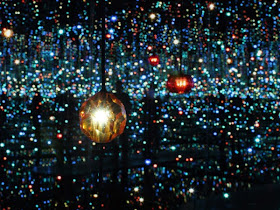2014
was the year niche moved out of the kennel (which is the meaning of the word in
French). Frédéric Malle and Le Labo were snapped up by the Estée Lauder group.
L’Artisan Parfumeur joined the Serge Lutens “export” series in certain Sephora stores –
and continued indulging in a practice that makes their retailers howl: not only
do they have online discount sales, but they slashed prices just before
Christmas at their uber-chic Le Bon Marché counter. Not to mention that thirteen
niche brands, including Arquiste, L’Artisan, Olfactive Studio and Miller
Harris, are now sold by Amazon France in a “Beauté Prestige” section
(Amazon.com carries different, less niche-y brands like Nuxe and L’Occitane).
On
the “nose” front, while Christine Nagel joined Hermès early this year to
succeed Jean-Claude Ellena, it was his daughter Céline Ellena who offered the
first non-Jean-Claude scents for the brand, a range of lovely home fragrances.
At Chanel, Olivier Polge presented his first fragrance in November, a new
Exclusive to be commercialized in March: Misia,
a gorgeously sensuous lipstick note on a furry, balsamic base. Dynasties have
always been a tradition in the perfume industry…
Scent-wise,
unsurprisingly, the oud tsunami shows no sign of relenting: Hermès and Chanel seem
to be the only ones holding out at this stage (Cartier gave in last summer with
a capsule collection). It's seeped into roses, which went woodier and darker – even the
mainstream is now flirting with oud-y roses now, as Clinique’s new pillar Beyond Rose demonstrates.
The
year has been rather rich in good mainstream fragrances – word around the labs has
it that budgets have been going up in recent briefs. Bottega Veneta Knot, Narciso Rodriguez Narciso, Clinique Beyond Rose, Jour d’Hermès Absolu, Terre d'Hermès Eau très fraîche, B. Balenciaga and Burberry Brit Rhythm for Her didn’t make the
final cut in this list, but only because it had to be kept down to 10
selections. I’d have also added the three Helmut Lang reeditions, Cuiron, Eau de cologne and Eau de
Parfum…
by
Olivier Polge and Jean-Christophe Hérault (IFF)
I
was so smitten by this that it went on my buy list as
soon as my 1.5 ml sample dried up. Perversely, one could say it’s all that La Vie est Belle could’ve been: an iris-y
gourmand whose foody tendencies are firmly kept in check with green, aromatic
notes. The secret ingredient is a brand-new extraction of carrot seed by IFF,
with woody, iris and apricot facets. This has been this winter’s staple for me.
by
Rodrigo Flores Roux (Givaudan)
Aedes
de Venustas has been consistently turning out fragrances with a strong
character – Copal Azur, its fourth
offering, impressed three of my friends so much they practically pried my
decants from my hands. Œillet Bengale
is a firecracker of a carnation for all of us spice-starved perfume lovers. Though
its style is contemporary, it packs a vintage-style punch.
by
Jean-Claude Ellena
The
latest Hermessence will not be Ellena’s swansong – there’s no definite date
announced for his retirement. But lately, his fragrances seems to have become
more emotional. And none the more so than Cuir
d’Ange, a tribute to his favorite writer Jean Giono in the form of a
floral, powdery leather scent as soft as the feather of a cherub.
by
Thierry Wasser
In
France, the limited-edition fragrance sold out in a matter of days (I see it’s
now back on the Guerlain website). Throughout the summer, I enjoyed the
similarly-scented body line – the tanning cream, self-tanner and after-sun
moisturizer are among my favorite products. Their radiant, zesty-green white
floral blend is an easy-going tropical delight.
by Mathilde Laurent
A
tribute to 80s rose chypres by way of the 1920s – there is a fleeting quote of Mitsouko --, La Panthère pounces out of the fruitchouli bushes we have to hack
our way through in cosmetics emporiums. Its gardenia and musk accord, silken in
the eau de parfum, goes feral in the extrait.
by
Carlos Benaïm (IFF)
Inspired
by magnolia headspace capture, this delicate scent reinvents 70s-style chypre colognes.
This is one fragrance that prompted many compliments -- and from perfumers, no
less.
by
Oliver Polge and Jean-Christophe Hérault (IFF)
The
last fragrance conceived under Nicolas Ghesquière’s tenure boasts the year’s
most covetable packaging. A deconstructed rose with aromatic, almost medicinal
notes, picked in a space-station apothecary’s garden.
Rose Infernale, Terry de Gunzburg
by
Sidonie Lancesseur (Robertet)
Butched
up with vetiver, incense and nutmeg, this is rose gone rogue: one of the year’s
most interesting takes on the flower.
by
Fabrice Pellegrin (Firmenich)
Far
from coming off as a novelty scent, this deconstruction of the cannabis note,
fiercely bitter, resinous and smoky, feels like smoke skimmed off a bottle of Bandit used as a Molotov cocktail. So
strikingly original Jean-Claude Ellena himself was spotted buying it in a
Parisian department store.
by Céline Ellena
Hermès’
poetic home fragrance collection features not only highly original compositions,
but the most charming presentation in this type of product, the origami horse. There’ll be a box of those in the leather-scented À cheval! under my Christmas tree even
if I have to purchase it myself!
For more 2014 round-ups, please visit:
And a very happy, fragrant New Year to you all!

























